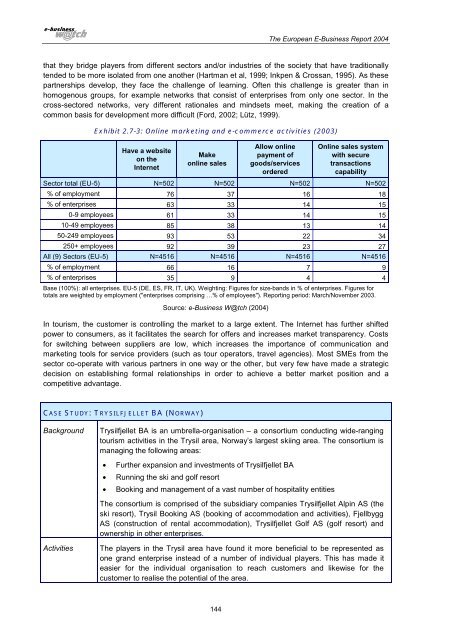The European e-Business Report 2004 - Berlecon Research GmbH
The European e-Business Report 2004 - Berlecon Research GmbH
The European e-Business Report 2004 - Berlecon Research GmbH
Create successful ePaper yourself
Turn your PDF publications into a flip-book with our unique Google optimized e-Paper software.
<strong>The</strong> <strong>European</strong> E-<strong>Business</strong> <strong>Report</strong> <strong>2004</strong>that they bridge players from different sectors and/or industries of the society that have traditionallytended to be more isolated from one another (Hartman et al, 1999; Inkpen & Crossan, 1995). As thesepartnerships develop, they face the challenge of learning. Often this challenge is greater than inhomogenous groups, for example networks that consist of enterprises from only one sector. In thecross-sectored networks, very different rationales and mindsets meet, making the creation of acommon basis for development more difficult (Ford, 2002; Lü tz, 1999).Exhibit 2.7-3: Online marketing and e-commerce activities (2003)Have a websiteon theInternetMakeonline salesAllow onlinepayment ofgoods/servicesorderedOnline sales systemwith securetransactionscapabilitySector total (EU-5) N=502 N=502 N=502 N=502% of employment 76 37 16 18% of enterprises 63 33 14 150-9 employees 61 33 14 1510-49 employees 85 38 13 1450-249 employees 93 53 22 34250+ employees 92 39 23 27All (9) Sectors (EU-5) N=4516 N=4516 N=4516 N=4516% of employment 66 16 7 9% of enterprises 35 9 4 4Base (100%): all enterprises. EU-5 (DE, ES, FR, IT, UK). Weighting: Figures for size-bands in % of enterprises. Figures fortotals are weighted by employment ("enterprises comprising … % of employees"). <strong>Report</strong>ing period: March/November 2003.Source: e-<strong>Business</strong> W@tch (<strong>2004</strong>)In tourism, the customer is controlling the market to a large extent. <strong>The</strong> Internet has further shiftedpower to consumers, as it facilitates the search for offers and increases market transparency. Costsfor switching between suppliers are low, which increases the importance of communication andmarketing tools for service providers (such as tour operators, travel agencies). Most SMEs from thesector co-operate with various partners in one way or the other, but very few have made a strategicdecision on establishing formal relationships in order to achieve a better market position and acompetitive advantage.CASE STUDY: TRYSILFJELLET BA (NORWAY)BackgroundTrysilfjellet BA is an umbrella-organisation – a consortium conducting wide-rangingtourism activities in the Trysil area, Norway’s largest skiing area. <strong>The</strong> consortium ismanaging the following areas:• Further expansion and investments of Trysilfjellet BA• Running the ski and golf resort• Booking and management of a vast number of hospitality entities<strong>The</strong> consortium is comprised of the subsidiary companies Trysilfjellet Alpin AS (theski resort), Trysil Booking AS (booking of accommodation and activities), FjellbyggAS (construction of rental accommodation), Trysilfjellet Golf AS (golf resort) andownership in other enterprises.Activities<strong>The</strong> players in the Trysil area have found it more beneficial to be represented asone grand enterprise instead of a number of individual players. This has made iteasier for the individual organisation to reach customers and likewise for thecustomer to realise the potential of the area.144
















